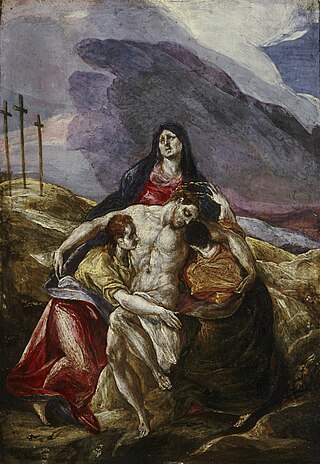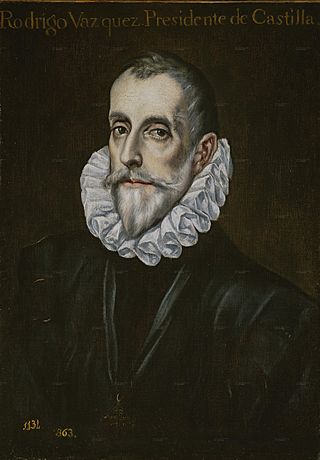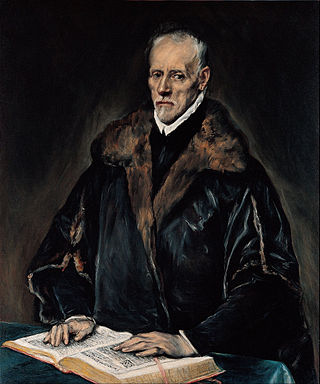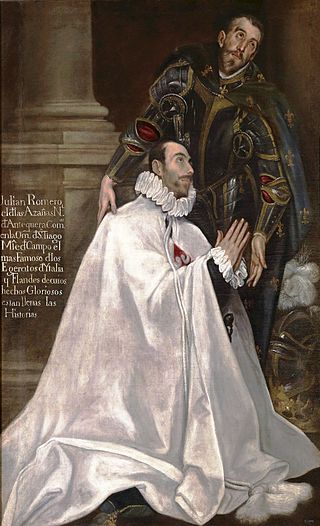
Domḗnikos Theotokópoulos, most widely known as El Greco, was a Greek painter, sculptor and architect of the Spanish Renaissance. El Greco was a nickname, and the artist normally signed his paintings with his full birth name in Greek letters, often adding the word Κρής, which means "Cretan".

The Prado Museum, officially known as Museo Nacional del Prado, is the main Spanish national art museum, located in central Madrid. It is widely considered to house one of the world's finest collections of European art, dating from the 12th century to the early 20th century, based on the former Spanish royal collection, and the single best collection of Spanish art. Founded as a museum of paintings and sculpture in 1819, it also contains important collections of other types of works. The Prado Museum is one of the most visited sites in the world and is considered one of the greatest art museums in the world. The numerous works by Francisco Goya, the single most extensively represented artist, as well as by Hieronymus Bosch, El Greco, Peter Paul Rubens, Titian, and Diego Velázquez, are some of the highlights of the collection. Velázquez and his keen eye and sensibility were also responsible for bringing much of the museum's fine collection of Italian masters to Spain, now one of the largest outside Italy.

The Nobleman with his Hand on his Chest is an oil painting by El Greco, one of the earliest works painted by the artist in Spain.

Annunciation is a 1575–1576 oil on canvas painting of the Annunciation by El Greco, one of the earliest paintings by the artist. It is now part of the Thyssen-Bornemisza Museum, in Madrid.

Pietà is a 1571-1576 painting by El Greco, produced just after his arrival in Rome and with clear influence from Michelangelo, although the triangular composition is El Greco's own invention. In the background is a landscape scene. It is now in the Philadelphia Museum of Art.

El Soplón or Boy Blowing on an Ember is a 1571-1572 oil on canvas painting by El Greco, produced during his stay in Rome and inspired by a passage in Pliny the Elder's Naturalis historia. It and Portrait of Giulio Clovio are among the first of his paintings of figures. He later re-used the figure for The Fable (1580).

Portrait of Giulio Clovio is a Renaissance era painting by El Greco c.1571. It was commissioned by Italian cardinal Alessandro Farnese during the artist's stay in Rome. It formed part of the Farnese collection. Charles of Bourbon inherited it in 1734 and moved it to Naples, where it now hangs in the Museo di Capodimonte.

Saint Peter is a 1608 oil on canvas painting produced by El Greco in Toledo towards the end of his life. It is now in the Monasterio del Escorial near Madrid.

Saint Anthony of Padua is a 1580 oil on canvas painting by El Greco, now in the Museo del Prado in Madrid.

Self-Portrait or Portrait of an Old Man is an oil-on-canvas painting by El Greco, dating to between 1595 and 1600 and usually identified as a self-portrait. It shows the influence of Titian and Tintoretto, whose works El Greco studied in Venice. It is now in the Metropolitan Museum of Art in New York.

Portrait of Rodrigo Vázquez de Arce is an anonymous copy of a lost 1587-1597 painting by El Greco. It is now in the Museo del Prado in Madrid. It shows Rodrigo Vázquez de Arce, president of the Council of Castille, who also features in the same artist's The Burial of Count Orgaz. Although it is different from other portraits by the artist, it still shows the strong influence of Titian and Tintoretto, who he had met in Venice.

Portrait of Antonio de Covarrubias is a 1595-1600 oil on canvas painting by El Greco, dating to his time in Toledo. It is now in the Louvre in Paris as the result of an exchange with Spanish museums in 1941.

Portrait of a Nobleman is a c.1586 oil on canvas portrait by El Greco, originally hung in the Quinta del Duque del Arco in Royal Palace of El Pardo in Madrid but now in the Museo del Prado. Its subject is unknown.

Portrait of a Young Nobleman is a 1600–1605 oil on canvas portrait by El Greco, originally in the quinta del Duque del Arco at the Royal Palace of El Pardo in Madrid but now in the Museo del Prado. It was long thought to show the poet Baltasar Elisio de Medinilla, but this has been disproven, and its subject is now unknown. It appears to have been influenced by portraits by Titian and Tintoretto, who El Greco knew whilst in Venice.

Portrait of Juan Pardo de Tavera is a 1609 oil on canvas painting by El Greco, now in the Hospital de Tavera in Toledo, founded by the portrait's subject. It was painted long after the 1545 death of its subject, cardinal Juan Pardo de Tavera, and so the artist modelled the cardinal's features on a funerary mask by Alonso Berruguete.

Portrait of Francisco de Pisa is a 1614 painting by El Greco, now in the Kimbell Art Museum in Fort Worth, Texas. Most art historians identify it as doctor Francisco de Pisa, a Spanish cleric, though a minority identify it as the Italian historian Giacomo Bosio due to the words shown in the open book. Francisco de Pisa was an enemy of Teresa of Ávila, who he criticised because he felt that her works contained "much that contradicts truth and sound doctrine and all good use of mental prayer". The pose of the subject is similar to that in Portrait of Cardinal Tavera, which is of a similar date.

Julián Romero and Saint Julian is a 1612-1614 painting by El Greco, now in the Museo del Prado in Madrid.

Portrait of Fray Hortensio Félix Paravicino is a 1609 oil on canvas painting by El Greco, now in the Museum of Fine Arts, Boston. It shows Hortensio Félix Paravicino, a monk of the Trinitarian Order and major Spanish poet who was also a close friend of the painter. He is shown in the Trinitarian habit.

Saint Peter and Saint Paul is a 1587-1592 painting by El Greco, one of several versions of the theme by the artist - others are now in Barcelona and Stockholm. It shows the apostles saint Peter and saint Paul. The work was once shown on a stamp produced by the USSR.

Saint Jerome is a 1609 painting by El Greco, now in the Frick Collection, New York.



















